"In my travels I found no answers, only wonders."
Marty Rubin
Continuing from the last write-up of my Northern Laos travelogue series, Cheryl and I arrived in the royal city of Luang Prabang on the 10th of February, a little before nine o'clock in the evening. While I love the sense of discovery in walking into yet another strange corner in this awesome world of ours, I also dislike the disorientation that it entails. Being an obvious tourist who can't speak the local language or read the local signs, we were subject to the mercy of the indigenous predators which prey on foreigners, taking advantage of their ignorance and naiveté. Cheryl was doing better than me because she can speak a smattering of Thai, which is similar enough to Lao to be useful in bargaining for stuff.
Unlike in Vientiane and Vang Vieng where I had made advanced bookings for guesthouses, we chose not to do the same for Luang Prabang - favouring instead the advice given in a few travel fora I frequented encouraging us to just walk around town carrying our backpacks until we see something we like. After about an hour of guesthouse operators telling us that they were full or that they were too expensive for me, we finally docked in at Tha Huea Me Guesthouse that faces the Mekong River at Mathatoulat Street. I had to pay a bit more than I wanted to but it was worth every kip, as most of the old city's attractions were located 5 minute's walk away from it,
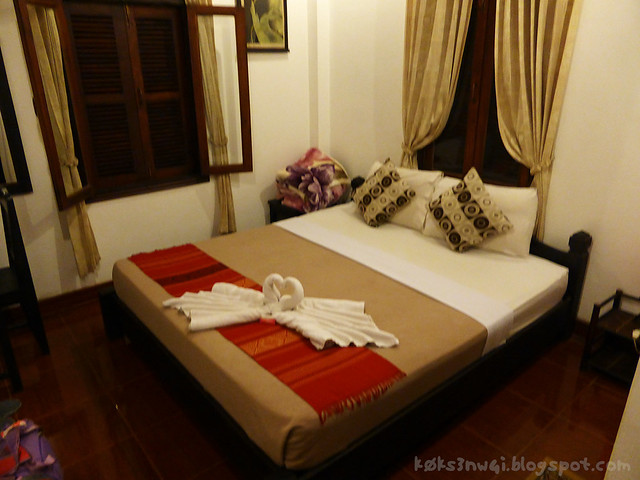 |
| Our room at Tha Huea Me Guesthouse. |
After unloading, we walked across the street to a riveside restaurant and had our first meal in Luang Prabang. We ordered a couple of dishes that Luang Prabang is famous for like orlam (a speciality stew of the region) but the highlight was flash-fried crispy Mekong riverweed (kai paen) which are algae gathered from the bottom of river that was hung up, dried, pounded and pressed into thin sheets with stuff like green onions, galangal, garlic or tomato, and sprinkled with sesame seeds. They tasted like a spicier version of nori. These are typically served with jeow bong, a delicious local sweet and spicy paste made from chillis, galangal, et cetera with rubbery bits of water buffalo skin in them.
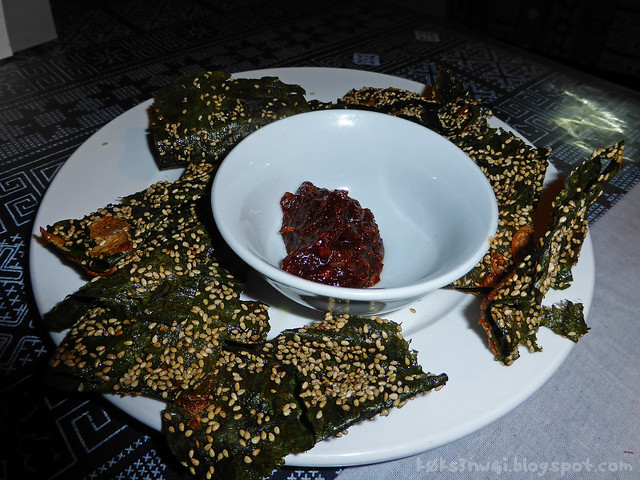 |
| The kai paen and jeow bong combo quickly became my new favourite food. |
Having spent most of the day riding a bus to get here, we wanted to stretch our legs a little before heading back to sleep so we walked to Rue Sisavangvong which is closed to motorised vehicles from 5 to 10 nightly to make way for the Handicraft Night Market.
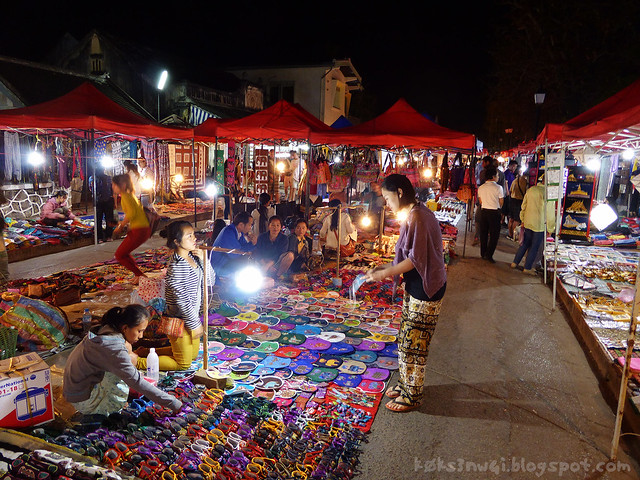 |
| Cheryl looking at baby bibs and baby shoes for Darwin, who was back in Penang with his maternal grandparents. |
I have read many testimonies from travellers in this region praising the Handicraft Night Market in Luang Prabang as the best shopping experience in Southeast Asia, to the exclusion of far more famous bazaars in Thailand and Vietnam. That's because a shopper is actually allowed to browse at their leisure without being harried and assaulted with pushy offers here. The peddlers here have pride and would not try to force a sale if you ultimately decide not to buy their wares, though I cannot divine how long this will stay the case. The variety and profusion of wares here are also quite impressive as they range from Beerlao T-shirts, metal-ware and jewelry fashioned from salvaged bombshells, woven apparel to paintings, woodcarvings, antiques and local teas.
Cheryl bought herself a pair of rainbow coloured hammer/harem pants, a very comfy type of trousers favoured by female Western travellers which I introduced to her in Vang Vieng (she was wearing one in the picture above), a painting for her sister, some pretty cushion covers for her parents, and a pair of craft baby booties for our baby boy. I bought a 5 inch tall wood sculpture of a woman in a rice paddy hat, just because.
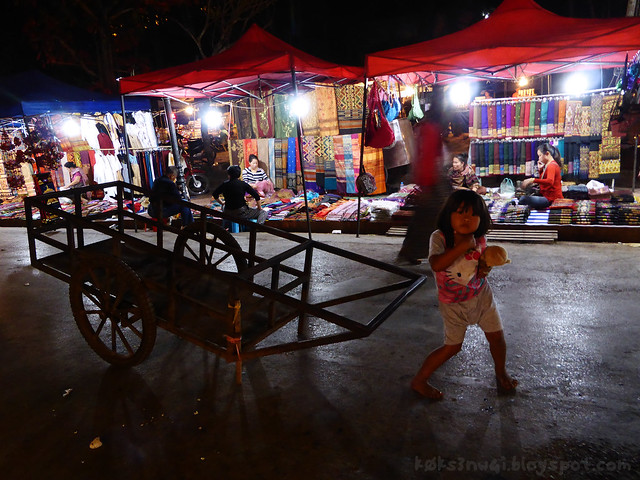 |
| A little girl at the Handicraft Night Market striking a pose when she saw me raise my camera. |
 |
| Another shot of the Night Market, with the opulent Haw Pha Bang or the Royal Chapel which houses Luang Prabang's most treasured relic (more on that in the next post) standing in the background. |
We got up early the next day and had our breakfast at a cheap looking corner shop located by the intersection of Manthatoulat and Kitsalat, literally a stone throw away from our guesthouse. A lot local Lao people were breakfasting there as well so we figured it must be good.
Between us, we had a bowl of noodle soup, a bowl Laotian rice soup (khào piak) and something that the hawker called "fried banana",
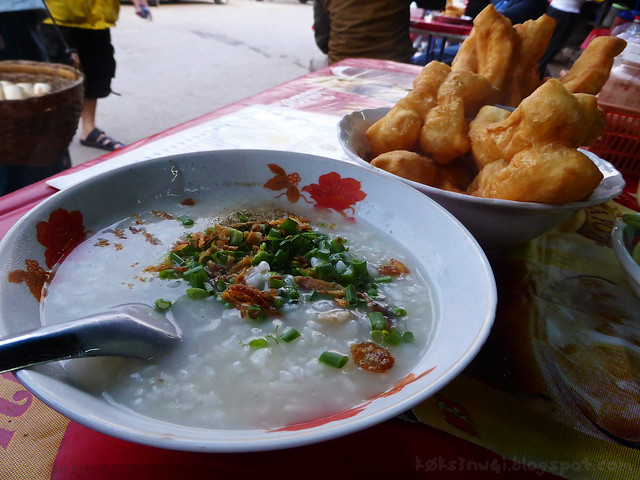 |
| Our breakfast. |
The "fried bananas" were no bananas at all but is actually the Lao version of the Chinese youtiao which I grew up with. The Lao people call them pah thawng ko. They are basically deep-fried strips of dough that frequently accompanies rice congee and bak kut teh in Malaysia.
Right after that, we decided to just take a stroll through the nearby Ban Pakam fresh market where all manners of raw edibles were on display and for sale.
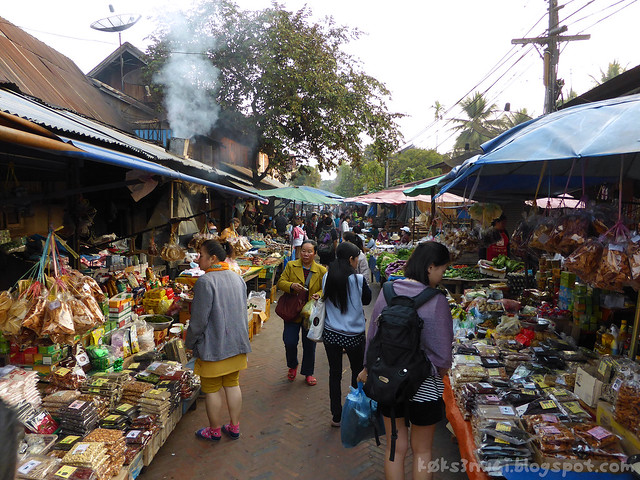 |
| In Cheryl's hand were 4 large packets of kai paen which I bought and later regretted. |
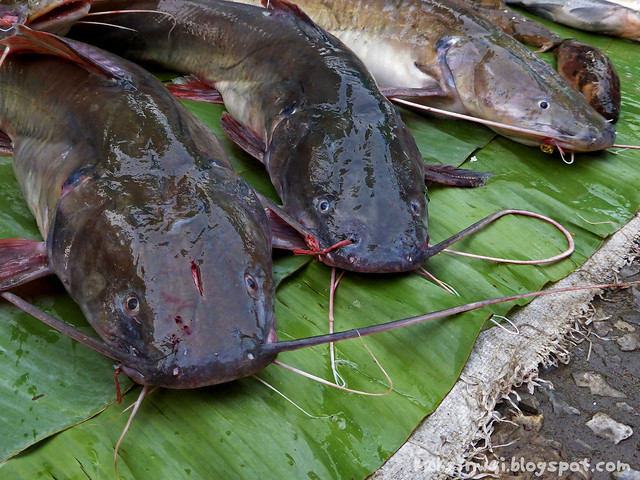 |
| Freshly caught and killed Mekong catfishes with eerily lively eyes for sale. |
This is just a brief introductory piece on Luang Prabang and just so you know, there are going to be many more posts in the pipeline about this awesomely quaint city as we spent almost 5 days there, more than anywhere else we spent in Laos. Anyway, after our visit to the morning market, we went and climbed Phou Si Hill which was located right in the middle of the historical district followed immediately by a visit to the Ho Kham (the Royal Palace Museum, former residence of the last monarchs of Laos) and the Haw Pha Bang to see the exalted symbol and palladium of Luang Prabang, from which the city got its name, before finally ending up at Wat Xieng Thong, one of the prettiest, most important monasteries and temples in the country.
RELATED POSTS:
Vive La Vientiane: Part One
Veni, Vidi, Vang Vieng: First Night in Town
Veni, Vidi, Vang Vieng: Climbing Pha Ngeun
Veni, Vidi, Vang Vieng: The Blue Lagoon at Tham Phu Kam
Veni, Vidi, Vang Vieng: Solo Mountain Biking Trip to Kaeng Nyui Waterfall
Veni, Vidi, Vang Vieng: Tubing Down the Nam Song
Veni, Vidi, Vang Vieng: Last Day in Town at Pha Poak and Lusi Cave
Sabaidee Luang Prabang: Phou Si Hill, Haw Kham and Wat Xieng Thong
Sabaidee Luang Prabang: Out Alone in the City
Not usually seen in markets,
k0k s3n w4i

2 comments:
Our family spent a wonderful month in Luang Prabang last April. We had a great time and really enjoyed our interactions with the locals. As noted not being hassled to "buy this mister" was great. Good accommodation from around $20 per room with en-suite, good food and excellent local beer.
Simon: Excellent local beer indeed. And a whole month in Luang Prabang? Sounds awesome!
Post a Comment